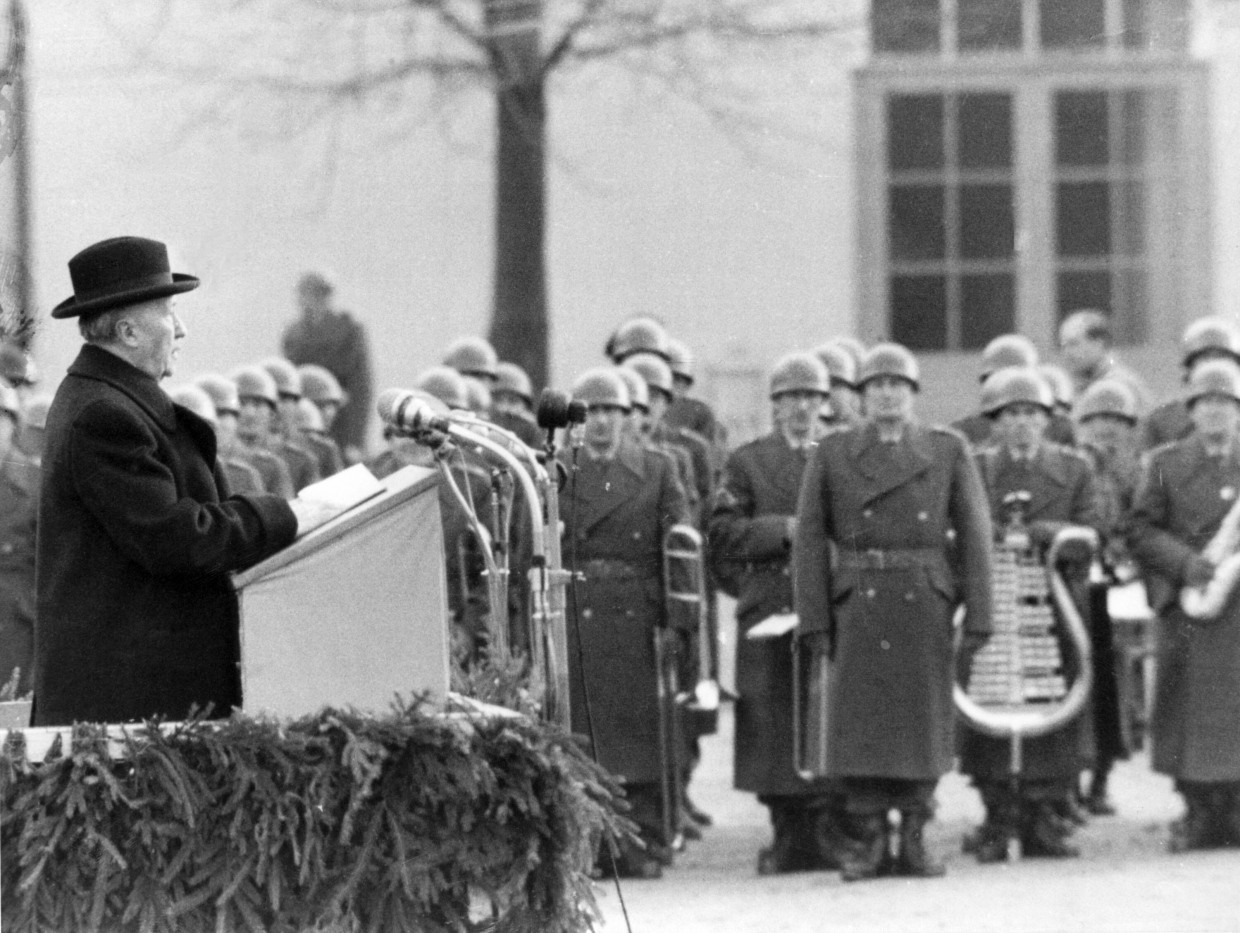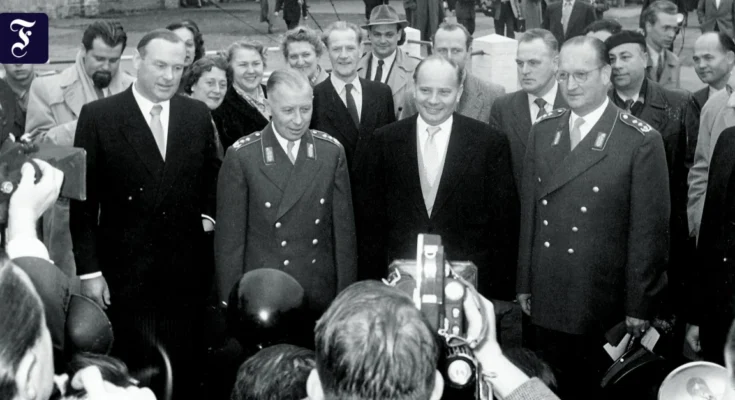The history of the Bundeswehr begins with a sentence that might have been uttered at a Christmas party: “We want to make this moment a moment of reflection, a very rare but healing reflection for us in the hustle and bustle of everyday life.” The moment that Federal Defense Minister Theodor Blank spoke about in his speech on November 12, 1955 was the appointment of the first 101 volunteers as soldiers in the Bundeswehr. However, the new German armed forces only received their name several months later.
The tone of the CDU politician’s sermon reflected the entire ceremony: ten years after the end of the war, anything that could raise fears among the German public and, above all, the international community that German militarism is on the rise again, must be avoided. The Ministry of Defense chose the “motor vehicle hall” at the Ermekeil barracks in Bonn as the venue, named after a family of innkeepers. The certificate was awarded by a politician who had not been defense minister in Germany in previous decades: a Catholic and former member of the IG mining council. They also did it without a group of high-profile guests. The Minister of Defense was the only prominent participant.
This non-military image was inadvertently reinforced by the dark clothing that most new soldiers wore because their uniforms were not ready on time. Only a life-sized iron cross in front of the black, red, and gold flag reminds us that tax officials were not sworn in at the barracks that day.
Adenauer wanted to create facts
The volunteers began serving even though discussions on military law were still ongoing in the Bundestag. It is the work of Konrad Adenauer. The Chancellor is concerned that conditions for building a new armed force could deteriorate significantly as time passes. Therefore, in 1955, while on holiday in the Black Forest, he arranged for voluntary legislation to be drawn up at short notice – without first consulting his defense minister. Contemporaries spoke of the “law of lightning.” This was intended to enable soldiers to be raised within a short time. From Adenauer’s point of view, no time-consuming changes to the Basic Law were needed – and therefore also no approval from the SPD, which, however, viewed it differently.
Adenauer wanted to create facts because he saw German arsenals in danger considering the thawing of mood in Moscow after Stalin’s death in 1953. After Washington, London and Paris accepted Moscow’s suggestion to hold a joint conference in 1955, the Chancellor feared that the victorious countries would reach an agreement at the expense of the Federal Republic.
He also saw problems emerging at home: the SPD responded to the Soviet initiative with a “program of negotiations for German unity.” Because leading SPD politicians viewed rearmament as an obstacle to German unity, Adenauer sensed the danger that the Social Democratic Party would return to its “no” stance toward the German armed forces.
In cinema newsreels, speakers described the ceremony as the first step toward a new “Bundeswehr.” There is no doubt that the armed forces cannot be called “Wehrmacht”. But there is broad consensus that the new armed forces will not completely break away from military traditions. The Wehrmacht was part of the criminal system and the Reichswehr was discredited as a “state within a state” in the Weimar Republic.
Therefore, in his speech on 12 November, Blank referred to the Prussian army reformer Gerhard von Scharnhorst, one of the spiritual fathers of general conscription in Prussia. November 12, 1955 was the general’s 200th birthday. The Scharnhorst quote that Blank used in his speech shows a shyness in the face of tradition: “It should be a tradition among soldiers to be at the forefront of progress.”
Applicants are screened for their Nazi past
The crucial question is whether the officers and generals who served Hitler could become defenders of democracy. The two highest ranking new soldiers who began serving on 12 November 1955 were Hans Speidel and Adolf Heusinger. Two of Defense Minister Blank’s most important military advisors once held leading positions in the Wehrmacht. Speidel was one of the conspirators on July 20, 1944, and Heusinger was one of the people who knew about the attack on Hitler. In 1957, Heusinger became the Bundeswehr’s first four-star general and its first inspector general.
In principle, it is not controversial that the leadership of the new armed forces must consist of former members of the Wehrmacht if they are to be led professionally. Adenauer commented that he could not send an 18-year-old general to NATO. However, there is great concern that National Socialists, war criminals and old-fashioned militarists could gain new honors in the Bundeswehr. Adenauer considered it sufficient if high officials recognized the Federal Republic’s ties with the West. However, this was not enough for the SPD, but also for influential politicians in the Union.
Of the 600 applicants, about 100 were rejected
This created an institution that was unique in postwar Germany in dealing with the National Socialist past in this form: the Personnel Assessment Committee, which examined all applications from the rank of colonel onwards. In this way, Parliament acquired a far-reaching instrument of control over personnel policy: nearly forty members, civilians of all political persuasions and senior officials, appointed by the Federal President on the advice of the Federal Government and approved by the Bundestag. According to the committee, of the approximately 600 applicants examined by December 1957, about a hundred were rejected or avoided by withdrawing their applications.
In his speech, Blank did not doubt the “primacy of politics,” even without using this formulation. A civilian is in charge of the Bundeswehr. The inspector general, as the top soldier, is subordinate to the defense minister, the civil secretary of state, and the senior director of civil ministries in the defense ministry. Blank outlines the ideal image of a Bundeswehr soldier, which in principle still applies today: that of a “citizen in uniform”, a soldier who identifies with the values of the Constitution and sees himself as a defender of democracy. The fact that Bundeswehr soldiers, as “citizens in uniform,” received the same rights as other citizens was not as obvious at the time as it often seems in retrospect. Adenauer and his FDP vice-chancellor, Franz Blücher, were skeptical about the right to vote for Bundeswehr soldiers.
Parliamentary army with Bundestag control rights
Adenauer favored an army subject only to government control. However, not only the SPD parliamentary group in the Bundestag opposes this, but also in the European Union, the main defense politicians insist on parliamentary control of the armed forces – because of their beliefs, but also because they consider an approach to the SPD important. On the one hand, because the government coalition had lost the two-thirds majority necessary for changes to the Basic Law since the breakup of the All-German Expulsion Bloc/Association in July 1955. But most importantly because the Union politicians wanted to place the Bundeswehr on the broadest possible social basis and also wanted to win over the workforce. This was made worse by the fact that Adenauer’s arbitrary approach to the Volunteers Act had alienated lawmakers from all factions.
The result of the struggle between the government and the Bundestag factions was the creation of a parliamentary army with broad rights of control over the Bundestag: the Bundestag Defense Committee was based on the Constitution and was empowered as an investigative committee. The Office of the Parliamentary Commissioner for the Armed Forces was also created based on the Swedish model.

This goes beyond the initial considerations for the creation of a new German army written by 15 former Wehrmacht officers in a memorandum in 1950 at the Himmerod Monastery in the Eifel in the name of Adenauer. It already contains important elements of the concept of “citizens in uniform”.
The plan received a strong boost from North Korea’s attack on South Korea that same year. The belief eventually emerged in Washington that German armed forces were essential to the defense of Western Europe.
Adenauer recognized this as an opportunity to achieve full sovereignty for the Federal Republic by offering defense contributions and linking the two. The first preparatory work for the new army was initially carried out by the “Home Service Center” under the direction of former Wehrmacht general Gerhard Graf von Schwerin. However, plans to create a “Federal Gendarmerie” failed due to the veto of the Western Allies. After the European Defense Community project also failed, the way for the creation of a new armed force was opened only with the joining of NATO in May 1955.
Resistance from the SPD and the church
From the start there was strong resistance to rearmament. The SPD initially rejected it. There are strong pacifist and anti-military tendencies in the party base. Within the party leadership, the German political argument was that rearmament would deepen Germany’s divisions. The so-called “No Me Movement” also drew inspiration from the progressive camp of the Protestant Church. Later Federal President Gustav Heinemann, who was Adenauer’s Minister of the Interior and at the same time President of the EKD Synod, resigned as minister in the fall of 1950, among other reasons.
It soon became clear that the Bundeswehr could not fulfill its duties with volunteers alone. The federal government had promised NATO twelve army divisions with a total strength of 500,000 men by 1959. There were barely enough volunteers to achieve this goal. By the end of 1956, 265,000 applications had been submitted, of which 175,000 were from former soldiers, although not all were fit for service.
The SPD does not deny that its commitment to NATO can only be fulfilled by conscription. Nevertheless, he initially advocated a professional army. Your leading defense politician, Fritz Erler, argued that the Bundeswehr no longer needed that many soldiers. He referred to NATO’s new defense concept introduced in 1954, which envisaged the use of tactical nuclear weapons. Lastly, the SPD also approved conscription, and chose it because they had previously pushed through their main demand for the creation of a parliamentary army.
This is how the era of the German volunteer army ended on April 1, 1957: On this day, the first conscripts moved into the barracks.



